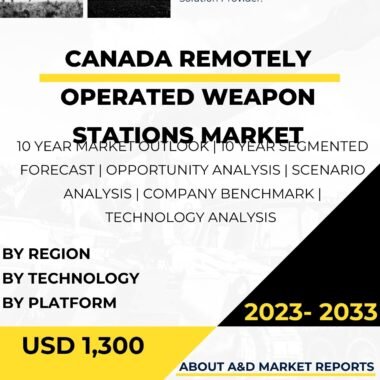Description
Canada’s defense industry places significant emphasis on training and simulation to enhance the readiness, effectiveness, and safety of the Canadian Armed Forces (CAF). Training and simulators play a crucial role in preparing military personnel for the complexities and challenges of modern warfare, providing them with realistic and immersive experiences without the risks associated with live exercises. These training methods cover a wide range of defense applications, including individual soldier training, collective training, vehicle and aircraft simulation, and joint and multinational exercises.
One of the primary goals of defense training in Canada is to ensure that military personnel are proficient in their respective roles and can effectively operate various equipment and systems. Individual soldier training focuses on developing essential skills, such as marksmanship, tactical movement, and communication. This training is often conducted in specialized training facilities and shooting ranges, where soldiers can practice their skills in a controlled and safe environment.
Collective training, on the other hand, involves the coordinated training of military units to improve teamwork, communication, and synchronization. Field exercises and live simulations allow units to work together in realistic scenarios, honing their abilities to conduct joint operations and respond effectively to various tactical challenges.
Simulators are integral to defense training, offering immersive and realistic experiences for military personnel. Flight simulators are widely used to train pilots, allowing them to practice flight maneuvers, emergency procedures, and operational scenarios in a virtual environment. Ground vehicle simulators offer similar benefits for training drivers and operators, providing a safe and cost-effective way to practice driving skills and vehicle operations.
Naval simulators are used to train maritime personnel in ship handling, navigation, and tactical procedures. These simulators enable sailors to gain practical experience in various maritime scenarios, such as docking, maneuvering, and anti-submarine warfare exercises, without the need for live sea trials.
Moreover, simulation is an essential component of joint and multinational exercises, where Canadian forces train and collaborate with allied partners. Virtual exercises conducted in simulated environments allow different military units and forces to practice joint operations, interoperability, and communication. This training strengthens military partnerships and ensures seamless cooperation during combined military missions.
The Canadian defense industry invests in research and development to continually advance training methods and simulation technologies. Collaborations with academia, domestic companies, and international partners facilitate knowledge sharing and technology transfer, keeping Canada at the forefront of defense training innovation.
As technology continues to evolve, virtual reality (VR) and augmented reality (AR) are becoming increasingly prevalent in defense training. VR and AR simulations provide trainees with immersive and interactive experiences, enabling them to practice skills and decision-making in realistic virtual environments. These technologies offer new opportunities for enhancing training effectiveness and preparing personnel for the challenges of modern warfare.
In addition to individual and collective training, simulators play a critical role in preparing CAF personnel for complex and hazardous scenarios. Simulated training scenarios allow soldiers to practice responding to emergencies, including chemical, biological, radiological, and nuclear (CBRN) incidents. This preparation ensures that CAF personnel are well-trained and ready to handle any crisis that may arise during their missions.
Beyond personnel training, simulators are instrumental in testing and evaluating new military equipment and technologies. Through simulation, defense researchers and engineers can assess the performance and safety of new systems, identify potential issues, and make necessary improvements before deploying them in real-world scenarios. This process reduces risks associated with unproven technologies and ensures that equipment meets required standards and specifications.
Simulation also supports the optimization of defense logistics and supply chain management. Telemetry data and simulation modeling help defense planners assess the impact of different logistics strategies, predict potential bottlenecks, and identify opportunities to improve efficiency and cost-effectiveness. The integration of simulation with AI and machine learning further enhances logistics planning by enabling predictive analytics and dynamic resource allocation.
Cybersecurity training is another essential aspect of defense training, given the increasing importance of protecting sensitive military information from cyber threats. Simulated cyber exercises allow military personnel to practice detecting and responding to cyber incidents in a realistic and controlled setting. These exercises enhance the readiness of cyber defense teams and ensure the protection of critical defense infrastructure.
Ensuring the security and integrity of defense simulations and training data is of utmost importance. Strong encryption and secure communication protocols protect data transmissions, preventing unauthorized access and potential cyber threats. Rigorous cybersecurity measures are implemented to safeguard the confidentiality and reliability of training and simulation data.
Ethical considerations are also addressed in defense training and simulation, particularly in scenarios that involve sensitive or conflict-related situations. Ensuring that training and simulation activities adhere to international humanitarian laws and ethical guidelines is essential to prevent misuse and maintain the integrity of the training process.
In conclusion, training and simulation are integral components of Canada’s defense industry, enhancing the readiness, effectiveness, and safety of the Canadian Armed Forces. Individual soldier training, collective training, and simulators prepare military personnel for the complexities and challenges of modern warfare, enabling them to operate various equipment and systems effectively. Simulation plays a crucial role in testing and evaluating new military equipment and technologies, reducing risks associated with unproven systems. Training and simulation support joint and multinational exercises, fostering cooperation and interoperability with allied forces. Continued investment in research and development ensures that Canada remains at the forefront of defense training and simulation innovation, preparing the country’s defense forces for the challenges and opportunities of modern military operations.




